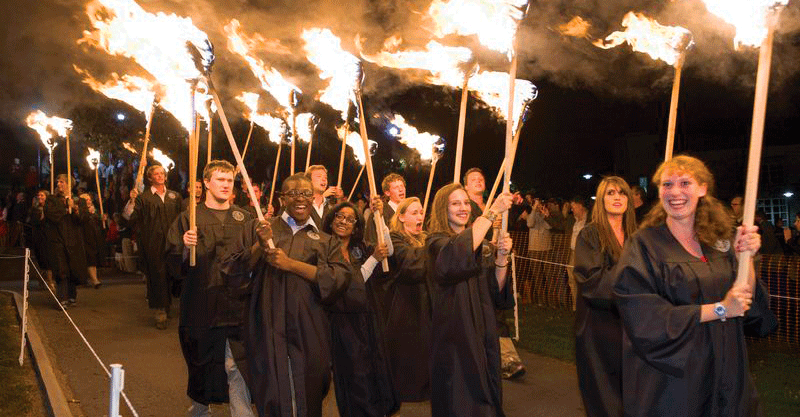Class of 2016 Debates New Traditions for Torchlight
Seniors process down the hill in a Colgate tradition that is currently undergoing a process of revisions.
On January 26, roughly 40 seniors gathered in Bunche House to discuss the current controversies surrounding Colgate’s Torchlight ceremony. The conversation was led by senior Samantha Hom, who came up with the idea after hearing student concerns pertaining to the ceremony. Hom is proposing purchasing class sweaters as an alternate and unifying attire option for seniors who do not want to wear a robe during Torchlight.
Torchlight is a long-standing Colgate tradition. On the eve of commencement, the graduating class processes down the hill, each senior wearing a graduation gown and carrying a torch.
Hom originally held an impartial attitude toward Torchlight. However, after her Discourses of Whiteness class began to discuss the ceremony Hom realized that not all of her peers felt the same way. Many students felt uncomfortable with the strong similarities between the optics of torchlight and the optics of Ku Klux Klan (KKK) activity—mainly, the combination of a torch and a long gown.
Hom is not the first to feel troubled by Torchlight’s possible visual and symbolic implications. In June 2014, a petition was drafted and signed by 31 people — Colgate faculty, staff and students regarding the ceremony.
“We ask that Colgate respectfully alter the tradition of the Torchlight Ceremony,” the petition stated.
Associate Professor of English and Africana and Latin American Studies Kezia Page remembers the petition as following an Intergroup Dialogue workshop for Colgate faculty and staff to discuss and work through issues of diversity.
“The workshop was an intense and moving experience. Difficult, even,” Page said.
The petition cited several ways in which the signers felt uncomfortable with the ceremony, including the history of KKK organizing in Madison County and historical instances of white supremacy in Colgate’s history, namely George Gavin Richie’s anti-slavery editorial in the Maroon-News in 1847 for which he was expelled.
“Among us, students, staff and faculty of color still so often experience racialized microaggressions that mark our campus as far less an inclusive community than we aspire to be,” the petition stated.
A Torchlight committee headed by Dean of Students Scott Brown convened after the petition’s circulation to engage in a critical conversation about Torchlight and how members of the Colgate community experience it.
Brown posed the central question of the discussion.
“How do we create a celebratory, unifying experience that’s inclusive for everybody?” Brown asked.
“I had some real questions about the roots of Torchlight,” Page said.
Page and many other members of the committee wanted to know whether or not Colgate’s Torchlight ceremony had been modeled or inspired by KKK rituals. Head of Special Collections and University Archivist Sarah Keen notes that there is no historical evidence that confirms Torchlight’s connection to activities performed by the KKK. In her research, Keen found that the Torchlight ceremony didn’t begin until the graduation ceremony of 1930, more than 100 years after the university was founded. At that time, the president of the Alumni Corporation Frank Williams convened a committee to discuss revising the commencement schedule, which at the time lasted three days and consisted of a mix of graduation and reunion activities. Upon visiting other east coast schools to observe and experience their graduation exercises, committee members found that torchlight services were a tradition performed by many other schools in the northeast predating the existence of the KKK.
Despite the fact that the birth of Colgate’s Torchlight ceremony was unconnected with the KKK, Hom believes the ceremony’s intentions are irrelevant in the discussion of whether or not its symbols are problematic and should be altered.
“I don’t understand why people need confirmation of a direct connection to have a problem with it. Isn’t it enough that people in the community can’t watch it and participate in it?” Hom said.
The alumni magazine describes Colgate’s first torchlight service as an illumination of campus in which the graduating class honored the late Frank Williams, Class of 1895, along with several of their deceased classmates. After processing down the hill, the class president lit a torch and passed the fire along to his classmates, lighting their torches one by one before singing the alma mater.
“As the last strains of the song died out, the light of the torches vanished. The touching effectiveness of this service assures its continuance as a traditional ritual of the seniors each year,” the alumni magazine said.
Associate Professor of Sociology Carolyn Hsu, who was also a member of the Torchlight committee, said the overall feel and experience of Torchlight has changed over the years.
Hsu said the current experience of Torchlight involving rowdy behavior is vastly different than the solemn feel of earlier ceremonies.
“In its current form, it is a celebration of a certain kind of partying involving a lot of alcohol and raucous behavior,” Hsu said.
Brown agreed with Hsu’s view.
“Torchlight has been a pretty dynamic ceremony over time, but the spirit of the ceremony has remained intact,” Brown said.
While some students and alumni enjoy this experience, it can be alienating to others. Campus climate surveys conducted by faculty in 2003 and 2009 found that many Colgate students felt that not enjoying or engaging in party culture made them outsiders who didn’t “belong” at Colgate.
Both Hom and Hsu noted that, in recent years, many students have faced the difficult decision of whether or not to participate in Torchlight.
“I’ve heard from Colgate graduates who said that their families just couldn’t handle coming anywhere near Torchlight. That left the graduates feeling torn and miserable–should they skip Torchlight and stay with their families? Or should they ditch their families and participate in the ritual that terrifies the people they love? The message they receive is that they don’t really belong to the Colgate community,” Hsu said.
The Torchlight committee was disbanded and did not continue their conversations this year, but Brown noted the members suggested a number of recommendations about ways to modify Torchlight.
According to Brown, there will be several changes to Torchlight ceremony implemented this year. Not only will faculty be invited to join the service, the ceremony will begin at 8 p.m., 30 minutes earlier than past years. Instead of meeting on the Academic Quad, seniors will gather in the chapel to hear from the class marshal, a student speaker, and sing the alma mater.
Many options have been discussed this year regarding changes to attire.
“In the past, students have worn their graduation robe during the Torchlight procession; however, we will not dictate that gowns must be worn,” said Vice President and Dean of the College Suzy Nelson in an email to The Colgate Maroon-News. “We support students in engaging their peers and discussing alternate attire options for the Torchlight ceremony.”
Brown believes these changes, along with previous modifications greatly reducing the size of the torch, will help create a different context for the ceremony that puts a stronger emphasis on its original purpose.
For example, Brown describes his first Torchlight ceremony as dean in 2008 as hectic and dangerous: people were yelling and throwing their torches at the bonfire from 50 feet away, a surging group of students who had clumped at the bottom of the hill formed a canopy of fire and some students even ran across Broad Street and began lighting fires on their front lawns.
“I was literally running around putting out fires with beers,” Brown said.
Members of the Colgate community hold very different opinions regarding whether or not modifications to the ceremony that do not address the two symbols – the torch and the robe – matter much regarding the ultimate issue of the ceremony’s inclusiveness.
“Because it’s not necessarily politically correct to say, ‘Oh yeah I know it offends people, let’s carry on,’ one way to be for [Torchlight] in a more nuanced, careful and sensitive way would be to be for it with revisions,” Page said.
Although Brown mentioned his belief that simplifying the conversation to just the clothing and the flame is a bit reductionistic, Hom disagrees. To her, it’s the symbolism of the robe and the torch combined that’s problematic and alienating. Hom came to this conclusion over the course of the fall semester and decided she wanted to try to do something to change it. After brainstorming several ideas to alter the ceremony, she decided modifying the attire would be the most realistic option. Hom came up with a design for class of 2016 sweaters, and researched pricing with several companies.
Hom mentioned an obstacle regarding pricing of the new sweaters, saying that ordering 782 sweaters, one for each senior, would cost about $40,000 at a price of $50 each. If 200 seniors ordered sweaters, they would cost about $60 each. If seniors wanted to order sweaters individually, they would cost $85 each.
Hom inquired about the possibility of finding funds to pay for the sweaters, either from alumni, parents or the administration, but has not had success thus far. The administration has stated that Colgate cannot designate special funds to help subsidize sweaters.
Several students, including senior Rachel Neal, have pointed out that until the outside funding of sweaters becomes a reality, the idea of sweaters as an alternate attire option is not universally unifying.
“Graduation is already an incredibly expensive time. Thus, additional costs like this…may not be an option for some students, leaving them with the options of being left out of the ceremony, or being very obviously separated from the rest of the community,” Neal wrote in the Class of 2016 Facebook group page.
Hom agrees, which is why she is continuing to search for a way to make an alternate attire option available to all members of the class.
The conversation about attire for this year’s Torchlight ceremony is spreading among the senior class, eliciting both support and criticism as well as sparking debates on Facebook.
One senior, Tobias Lescht, was motivated to run for a seat in the SGA senate after reading a conversation of Facebook posts discussing the issue.
“I think there really needs to be an open discussion. A vast majority of people on campus want to keep the torchlight ceremony, [but] they don’t feel comfortable speaking out because they’re immediately labeled racist. That’s not constructive… part of free speech is that everyone’s opinions should be valued,” Lescht said.
“I think [the sweater] is a really nice idea. I think that we as a campus have a responsibility to take the concerns of members of our community seriously, and if the imagery of robes and fire evokes fear and senses of danger, then it seems immoral to persist in carrying on a tradition that hurts people… I hope that people can find commonalities in human empathy,” senior Julia Yarrington said.
Senior Brett Christensen agreed.
“It allows us to keep the community aspect of the tradition. Plus, how cool would it be to have a nice Colgate sweater as a keepsake?” Christensen said.
Hom is somewhat disappointed that her idea is causing so much dissonance within the senior class.
“My purpose in this wasn’t to start a divide in the class. My hope was that we would all be unified in a different way. I don’t want this sweater thing to live and die with us – I want it to become a part of Colgate,” Hom said.
SGA President and senior Kegan Thompson noted how he thinks that, with funding, the class sweaters could become a powerful new Colgate tradition, whether they are permanently connected to Torchlight or not.
“It seems that for the foreseeable future, students will have to decide for themselves what they want to wear to Colgate’s Torchlight ceremony. I, however, will be wearing a Colgate class sweater,” Thompson said.




